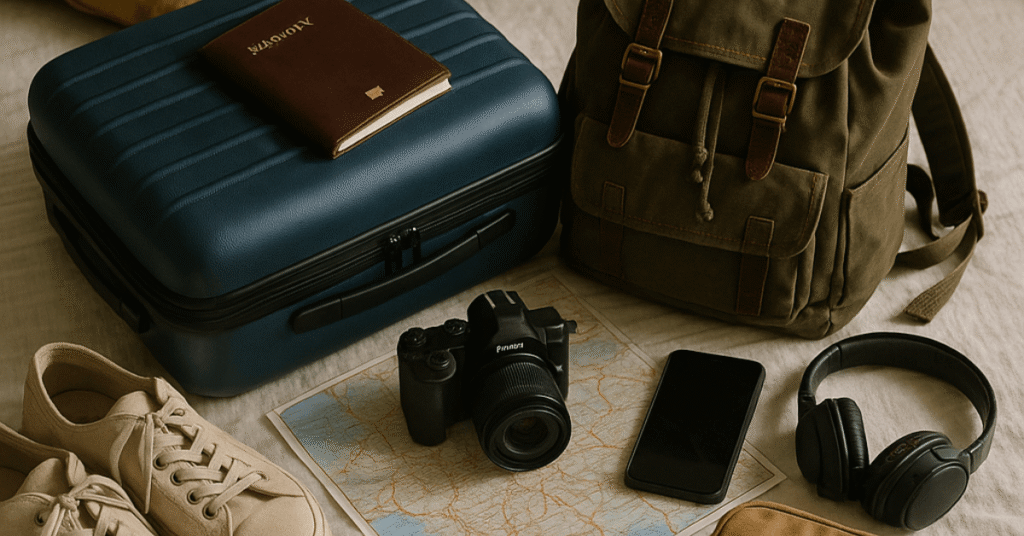Embarking on a long-term journey is both thrilling and challenging. Whether you’re planning to explore Southeast Asia for six months, live in Europe for a year, or take a round-the-world trip, having the right essentials can make or break your experience.
In this comprehensive guide, you’ll discover everything you need to pack, prepare, and organize for a successful long-term travel adventure — including tech, documents, clothing, health items, digital tools, and smart planning tips.
Why Packing Smart Matters More Than Packing Heavy
Many first-time long-term travelers fall into the trap of overpacking. But seasoned nomads know: the more you carry, the more you suffer. The key is to pack strategically, not excessively.
You’ll be moving frequently, navigating airports, hostels, and taxis. You’ll face various climates and situations. The right gear will support your mobility, independence, and comfort.
Minimalist doesn’t mean going without. It means choosing items that are:
- Multi-functional
- Durable
- Lightweight
- Compact
Let’s break it down by categories so you can prepare with confidence.
Travel Documents and Financial Essentials
Before you even pack your bag, make sure your most critical documents and accounts are in order. These include:
- Passport (valid for at least 6–12 months beyond your return date)
- Visa documents (including printouts and copies)
- International driver’s license if applicable
- Vaccination records or digital proof
- Travel insurance documentation
- Emergency contact list
Also, prepare your finances:
- Multiple debit/credit cards from different banks
- Backup cash in USD or EUR (widely accepted globally)
- Currency conversion app (like XE or Revolut)
- Notify your bank of travel plans to avoid blocked cards
- Digital wallet options (PayPal, Wise, Apple Pay)
Pro tip: Take photos of all documents and store them securely in the cloud and on a USB drive for backup.
The Perfect Travel Backpack or Luggage
Your bag is your mobile home. For long-term travel, most nomads prefer:
- 40–55L backpack with hip support (carry-on size)
- Compression packing cubes to save space
- Daypack for excursions and work days
- Waterproof cover or travel poncho
If you’re not comfortable carrying a backpack, consider a hybrid rolling duffel with backpack straps.
Focus on weight distribution, accessibility (front-loading is best), and durability. Brands like Osprey, Nomatic, and Tortuga are traveler favorites.
Clothing: Versatility Over Volume
Long-term travel means you’ll need clothes for multiple climates and activities. Use the 10-5-3 Rule as a packing framework:
- 10 tops (mix of t-shirts, long-sleeves, tank tops)
- 5 bottoms (jeans, leggings, shorts, joggers)
- 3 outerwear items (rain jacket, hoodie, insulated layer)
Other clothing essentials:
- Underwear and socks (7–10 pairs)
- Swimwear
- Sleepwear
- Light scarf or sarong (multi-use)
- Hat and sunglasses
- Flip-flops and one pair of walking shoes
- Lightweight sneakers or hiking shoes (depending on trip style)
Choose materials like merino wool or quick-dry synthetics. Neutral colors work better for mix-and-match outfits.
Toiletries and Personal Care
Keep it minimal, especially if traveling to regions where products are easily accessible. Bring:
- Reusable travel bottles with essentials (shampoo, soap, lotion)
- Microfiber towel
- Toothbrush, toothpaste, floss
- Solid bar soap or shampoo bar to save space
- Sunscreen and insect repellent
- Menstrual products or reusable cup
- Small first aid kit (band-aids, antiseptic, ibuprofen)
- Nail clippers, tweezers, small scissors
- Hairbrush or comb
Toiletry bags that hang or roll up are great space savers.
Health and Safety Essentials
Don’t skip on health gear — even if you’re young and healthy. Consider packing:
- Basic medical kit (allergy meds, painkillers, rehydration tablets)
- Prescription medications (enough for your entire trip)
- Travel insurance card and contact info
- Hand sanitizer and face masks
- Reusable water bottle with filter (like LifeStraw)
- Electrolyte tablets or powder
- Compact thermometer
You may also want a small mosquito net, especially for Southeast Asia or South America.
Essential Travel Tech
Tech can streamline your travel, especially if you’re working remotely. Bring:
- Lightweight laptop and charger
- Universal travel adapter
- Unlocked smartphone
- Noise-canceling headphones
- Power bank (10,000+ mAh)
- External hard drive or SSD
- USB cable and extension cord
- Portable Wi-Fi hotspot or SIM kit
Optional but helpful:
- Kindle or e-reader
- GoPro or camera with SD cards
- Mini tripod
- Bluetooth keyboard or mouse
Backup everything to the cloud regularly to avoid data loss.
Must-Have Apps for Long-Term Travelers
Turn your phone into your travel assistant. Top apps include:
- Google Maps (offline downloads)
- Maps.me for trails and offline walking maps
- Skyscanner and Google Flights
- Rome2Rio for transport planning
- Booking.com and Hostelworld
- Google Translate
- Splitwise for group travel expenses
- XE Currency
- Trail Wallet for budget tracking
For work, add:
- Slack, Zoom, Google Drive
- Trello or Notion
- VPN app like NordVPN or Surfshark
Digital Backup and Cloud Organization
Losing access to important documents or work can ruin your trip. Always:
- Back up critical files to the cloud (Google Drive, Dropbox)
- Carry digital copies of your passport, insurance, and bookings
- Organize folders by location or month
- Use password managers like 1Password or Bitwarden
Stay protected and organized, especially when changing devices or accessing shared networks.
Travel Planning and Booking Strategy
Long-term trips require smart planning without overplanning. Tips:
- Book your first destination and accommodation only
- Use flexible booking sites (with free cancellation)
- Track flights with alerts from Hopper or Skyscanner
- Stay at least 7 days in one place to lower costs
- Join Facebook groups for local housing and advice
- Use Workaway, Trusted Housesitters, or Worldpackers for volunteering and homestays
Balance structure and spontaneity. Too much rigidity can limit your freedom.
Security and Anti-Theft Gear
Theft can happen anywhere. Protect yourself with:
- Money belt or neck pouch
- Anti-theft backpack with lockable zippers
- Luggage locks and cable
- Hidden pockets or stash wallets
- Small safe or lockbox if carrying valuables
- RFID-blocking cards or sleeves
Be discreet with your tech, and never leave gear unattended in public.
Sustainable Travel Essentials
Long-term travelers impact the environment. Reduce your footprint with:
- Reusable cutlery and straw
- Canvas shopping bag
- Eco-friendly toiletries
- Reusable water bottle
- Laundry soap sheets or powder
Support local businesses, travel slowly, and offset your flights when possible.
Mindset: The Most Important Essential
No gear can replace the right mindset. Prepare to be:
- Flexible — plans will change, buses will be late
- Patient — things take longer abroad
- Curious — embrace new cultures, foods, and customs
- Open-minded — leave expectations at home
- Prepared to disconnect — not every moment needs to be posted
Travel will challenge you emotionally and mentally. That’s part of its beauty.
Final Thoughts: Travel Light, Live Large
When you’re living out of a bag for months or years, every item counts. The right travel essentials give you freedom, peace of mind, and the ability to adapt on the go.
But remember — it’s not about having everything. It’s about having what you need to feel safe, productive, and open to adventure.
With smart packing, organized systems, and a grounded mindset, you’ll be ready to thrive anywhere the road takes you.
Elaine A. da Silva is a Brazilian travel and finance enthusiast, best known as the creator of the blog Dica das Milhas. With a strong background in personal finance and a passion for exploring smart travel strategies, she specializes in simplifying the world of airline miles and travel rewards for everyday people. Through her blog, Elaine shares practical tips, insider knowledge, and step-by-step guides to help readers save money and travel more efficiently using loyalty programs and credit card points.







